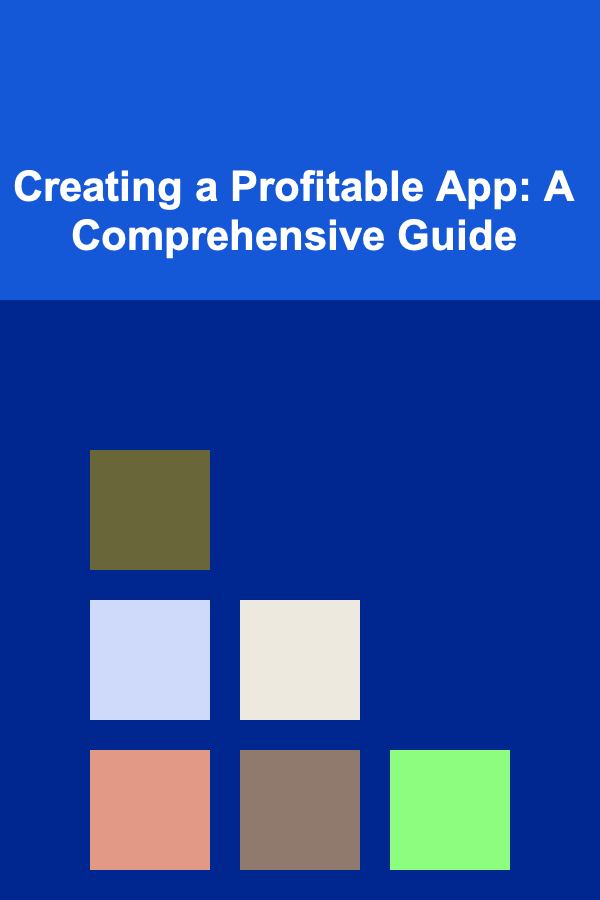
Creating a Profitable App: A Comprehensive Guide
ebook include PDF & Audio bundle (Micro Guide)
$12.99$8.99
Limited Time Offer! Order within the next:

Introduction: The App Gold Rush and the Harsh Reality
The app market is a digital gold rush. Millions of apps vie for attention on app stores, promising to solve problems, entertain, and connect people. While success stories abound, the reality is that only a small percentage of apps achieve significant profitability. The journey from idea to successful app requires more than just technical prowess. It demands a strategic approach that considers market needs, user experience, monetization strategies, and continuous improvement.
This guide aims to provide a comprehensive roadmap for navigating the complexities of the app development process, focusing on key areas that are crucial for building a profitable application. We'll explore everything from identifying a viable market opportunity to scaling your app for long-term growth. We'll delve into the crucial aspects often overlooked, offering insights applicable across different app categories and business models.
Phase 1: Idea Validation and Market Research -- Laying the Foundation
Before writing a single line of code, thorough idea validation and market research are essential. This phase determines if your app idea has the potential to resonate with users and generate revenue. Rushing into development without validating your assumptions is a recipe for disaster.
1. Identifying a Problem Worth Solving
The most successful apps address a genuine problem or fulfill a specific need. Ask yourself: What pain point does my app solve? Is it a widespread problem, or a niche issue? Does it offer a significantly better solution than existing alternatives? Consider the following approaches:
- Personal Experience: Draw from your own frustrations and identify areas where an app could improve your life or the lives of others.
- Market Gaps: Analyze existing apps and identify areas where they fall short. Look for unmet needs or underserved user segments.
- Industry Trends: Stay informed about emerging trends and technologies. Consider how you can leverage these trends to create innovative app solutions.
- Community Feedback: Engage with online communities, forums, and social media groups to identify common pain points and gather feedback on potential app ideas.
2. Conducting Market Research
Once you have a solid app idea, it's time to validate its potential through market research. This involves gathering data to understand your target audience, competition, and market trends. Key areas to investigate include:
- Target Audience: Define your ideal user. Consider demographics, interests, behaviors, and technical proficiency. Create user personas to represent different segments of your target audience.
- Competitive Analysis: Identify your direct and indirect competitors. Analyze their strengths, weaknesses, pricing strategies, and user reviews. What are they doing well? Where can you differentiate your app? Tools like Sensor Tower, App Annie (now data.ai), and Apptopia can provide valuable insights into competitor performance.
- Market Size and Growth: Estimate the potential market size for your app. Is the market growing, shrinking, or stagnant? Look for industry reports and market forecasts to get a sense of the overall market opportunity.
- Keyword Research: Identify the keywords that users are likely to use when searching for apps like yours. Use tools like Google Keyword Planner, Ahrefs, or SEMrush to find relevant keywords with high search volume and low competition.
3. Validating Your Idea
Market research provides valuable insights, but it's essential to validate your idea directly with potential users. This can be done through:
- Surveys: Create online surveys to gather feedback on your app concept and features. Use platforms like SurveyMonkey or Google Forms.
- Interviews: Conduct one-on-one interviews with potential users to gain a deeper understanding of their needs and preferences.
- Focus Groups: Organize focus groups to gather feedback from a group of potential users in a collaborative setting.
- Landing Pages: Create a simple landing page to describe your app and collect email addresses from interested users. This allows you to gauge interest and build an email list for future marketing efforts.
- Prototypes and MVPs: Create a low-fidelity prototype or Minimum Viable Product (MVP) to test your app's core functionality with real users. Gather feedback and iterate based on their experience.
Remember: Be prepared to pivot! If your research reveals that your initial idea isn't viable, don't be afraid to adapt or even abandon it. It's better to learn early than to waste time and resources on a failing project.
Phase 2: App Design and Development -- Building a Solid Product
Once you've validated your app idea, it's time to focus on design and development. This phase involves creating a user-friendly interface, writing clean and efficient code, and ensuring a seamless user experience.
1. User Interface (UI) and User Experience (UX) Design
UI/UX design is crucial for attracting and retaining users. A well-designed app should be intuitive, visually appealing, and easy to navigate. Consider the following:
- User-Centered Design: Prioritize the needs and preferences of your target audience. Conduct user research to understand their expectations and design your app accordingly.
- Information Architecture: Organize your app's content and features in a logical and intuitive manner. Create a clear navigation structure that allows users to easily find what they're looking for.
- Visual Design: Choose a visually appealing color palette, typography, and imagery that aligns with your brand and target audience. Maintain consistency throughout the app.
- Accessibility: Design your app to be accessible to users with disabilities. Follow accessibility guidelines (e.g., WCAG) to ensure that your app is usable by everyone.
- Prototyping: Create interactive prototypes to test your app's usability and gather feedback before development. Tools like Figma, Adobe XD, and Sketch are popular choices.
2. Choosing the Right Development Approach
There are several approaches to app development, each with its own advantages and disadvantages. Consider the following options:
- Native Development: Developing apps specifically for iOS (using Swift or Objective-C) and Android (using Java or Kotlin) offers the best performance and access to platform-specific features. However, it requires separate codebases for each platform, which can be more expensive and time-consuming.
- Cross-Platform Development: Using frameworks like React Native, Flutter, or Xamarin allows you to write code once and deploy it on multiple platforms. This can save time and money, but may result in slightly lower performance or limited access to certain native features.
- Hybrid Development: Using web technologies like HTML, CSS, and JavaScript within a native container. Frameworks like Ionic and Cordova fall into this category. Offers rapid development but can suffer from performance issues.
- No-Code/Low-Code Development: Platforms like Bubble, AppGyver, and Adalo allow you to build apps without writing any code or with minimal coding. This is a good option for simple apps with limited functionality.
The best approach depends on your budget, timeline, and technical expertise. Native development is generally preferred for complex apps that require high performance and access to native features. Cross-platform and hybrid development are suitable for simpler apps where speed and cost are more important.
3. Agile Development Methodology
Employing an agile development methodology can significantly improve the development process. Agile emphasizes iterative development, collaboration, and continuous feedback. Key principles of agile include:
- Sprints: Breaking down the development process into short, iterative cycles (sprints) allows for frequent testing and feedback.
- Daily Stand-ups: Short daily meetings to discuss progress, identify roadblocks, and coordinate tasks.
- User Stories: Describing features from the user's perspective to ensure that the development team understands the requirements.
- Continuous Integration and Continuous Delivery (CI/CD): Automating the build, testing, and deployment process to ensure rapid and reliable releases.
4. Testing and Quality Assurance (QA)
Thorough testing is essential for ensuring that your app is bug-free and performs as expected. Implement a comprehensive testing strategy that includes:
- Unit Testing: Testing individual components of the code to ensure that they function correctly.
- Integration Testing: Testing the interaction between different components of the code.
- System Testing: Testing the entire app to ensure that it meets the requirements.
- User Acceptance Testing (UAT): Testing the app with real users to gather feedback and identify any usability issues.
- Regression Testing: Retesting the app after making changes to ensure that no new bugs have been introduced.
- Automated Testing: Using automated testing tools to speed up the testing process and improve accuracy.
5. Security Considerations
App security is paramount, especially when dealing with sensitive user data. Implement security measures to protect your app from vulnerabilities and attacks. Key security considerations include:
- Data Encryption: Encrypting sensitive data both in transit and at rest.
- Authentication and Authorization: Implementing secure authentication and authorization mechanisms to protect user accounts.
- Input Validation: Validating user input to prevent injection attacks.
- Secure Storage: Using secure storage mechanisms to protect sensitive data on the device.
- Regular Security Audits: Conducting regular security audits to identify and address vulnerabilities.
Phase 3: Monetization Strategies -- Turning Your App into a Revenue Stream
Choosing the right monetization strategy is crucial for generating revenue from your app. The best approach depends on your app's category, target audience, and business model. Here are some popular monetization strategies:
1. In-App Purchases (IAPs)
IAPs allow users to purchase virtual goods, services, or features within your app. This can include:
- Consumable Items: Items that can be used multiple times, such as coins, gems, or power-ups in a game.
- Non-Consumable Items: Items that can be purchased once and used indefinitely, such as premium features or ad-free access.
- Subscriptions: Recurring payments for access to premium content, features, or services.
IAPs are commonly used in games, entertainment apps, and productivity apps. The key is to offer valuable items that enhance the user experience without being overly intrusive or pay-to-win.
2. Advertising
Advertising involves displaying ads within your app. There are several types of ad formats, including:
- Banner Ads: Small, rectangular ads that are displayed at the top or bottom of the screen.
- Interstitial Ads: Full-screen ads that are displayed at natural transition points in the app, such as between levels in a game.
- Rewarded Video Ads: Ads that users can choose to watch in exchange for a reward, such as in-game currency or extra lives.
- Native Ads: Ads that are designed to blend in with the app's content and user interface.
Advertising is a popular monetization strategy for free apps. It's important to balance revenue generation with user experience. Too many ads can be intrusive and lead to user churn.
3. Freemium Model
The freemium model offers a basic version of your app for free, with the option to upgrade to a premium version for additional features or benefits. This can include:
- Feature-Locked Freemium: Offering a limited set of features in the free version, with the option to unlock additional features in the premium version.
- Usage-Based Freemium: Offering a limited amount of usage in the free version, with the option to purchase more usage in the premium version.
- Time-Limited Freemium: Offering a free trial of the premium version for a limited time, after which users must pay to continue using the premium features.
The freemium model is effective for attracting a large user base and converting a portion of them into paying customers. The free version must provide enough value to attract users, while the premium version must offer compelling features that justify the cost.
4. Subscription Model
The subscription model involves charging users a recurring fee for access to your app's content, features, or services. This can include:
- Content Subscriptions: Providing access to a library of content, such as articles, videos, or music.
- Feature Subscriptions: Providing access to premium features, such as advanced editing tools or cloud storage.
- Service Subscriptions: Providing access to a service, such as online courses or personal coaching.
The subscription model is ideal for apps that offer ongoing value to users. It provides a recurring revenue stream and allows you to build a loyal customer base. Offering a free trial or freemium version can help attract new subscribers.
5. Paid App
Charging users a one-time fee to download your app. This model is becoming less common due to the popularity of free apps and the freemium model. However, it can still be viable for apps that offer unique value or cater to a niche market.
6. Affiliate Marketing
Promoting other products or services within your app and earning a commission on sales generated through your affiliate links. This can be a good way to monetize your app without relying on in-app purchases or advertising. Be sure that the affiliate products are relevant to your audience and align with your app's purpose.
7. Data Monetization (Proceed with Caution)
Collecting and selling user data to third parties. This is a controversial monetization strategy that can raise privacy concerns and damage your app's reputation. It's crucial to be transparent about your data collection practices and obtain user consent before collecting and selling their data. Consider the ethical implications carefully before pursuing this strategy, and always comply with privacy regulations like GDPR and CCPA.
No matter which monetization strategy you choose, it's important to track your results and make adjustments as needed. Monitor key metrics such as conversion rates, average revenue per user (ARPU), and customer lifetime value (CLTV) to optimize your monetization strategy and maximize your revenue.
Phase 4: Marketing and Promotion -- Getting Your App Discovered
A great app is useless if no one knows about it. Effective marketing and promotion are crucial for driving downloads and building a user base. Here are some key marketing strategies:
1. App Store Optimization (ASO)
ASO is the process of optimizing your app's listing in the app stores to improve its visibility and ranking in search results. Key ASO factors include:
- App Name: Choosing a relevant and descriptive app name that includes relevant keywords.
- Keywords: Identifying and targeting relevant keywords in your app's title, subtitle, and keyword field.
- Description: Writing a compelling and informative app description that highlights the key features and benefits of your app.
- Screenshots and Videos: Creating visually appealing screenshots and videos that showcase your app's user interface and functionality.
- Ratings and Reviews: Encouraging users to leave positive ratings and reviews, as these can significantly impact your app's ranking and credibility.
Tools like Sensor Tower, App Annie (data.ai), and Apptopia can help you track your ASO performance and identify areas for improvement.
2. Social Media Marketing
Using social media platforms to promote your app and engage with your target audience. Key social media marketing tactics include:
- Creating Engaging Content: Sharing relevant and engaging content that highlights the benefits of your app and provides value to your audience.
- Running Targeted Ads: Using social media advertising platforms to target specific demographics and interests.
- Influencer Marketing: Partnering with influencers to promote your app to their followers.
- Community Building: Building a community around your app by creating a Facebook group, Twitter account, or other online forum.
3. Content Marketing
Creating valuable and informative content to attract and engage your target audience. This can include:
- Blog Posts: Writing blog posts about topics related to your app and your target audience.
- Infographics: Creating visually appealing infographics that present information in a concise and engaging manner.
- Ebooks: Writing ebooks that provide in-depth information about a specific topic related to your app.
- Videos: Creating videos that demonstrate how to use your app or provide tips and tricks.
4. Paid Advertising
Running paid advertising campaigns on app stores, social media platforms, and search engines. This can be a cost-effective way to drive downloads and acquire new users. Key paid advertising channels include:
- App Store Ads: Advertising your app directly within the app stores.
- Google Ads: Running search and display ads on Google.
- Social Media Ads: Running ads on social media platforms like Facebook, Instagram, and Twitter.
5. Public Relations (PR)
Reaching out to journalists, bloggers, and other media outlets to generate coverage for your app. This can be a highly effective way to raise awareness and drive downloads. Key PR tactics include:
- Press Releases: Issuing press releases to announce new app features, milestones, or partnerships.
- Media Outreach: Contacting journalists and bloggers directly to pitch your app.
- Industry Events: Attending industry events to network with media representatives and promote your app.
6. Email Marketing
Building an email list and sending targeted emails to promote your app and engage with your users. This can be a highly effective way to nurture leads and drive conversions. Key email marketing tactics include:
- Welcome Emails: Sending a welcome email to new users to introduce them to your app and highlight its key features.
- Promotional Emails: Sending promotional emails to announce new features, discounts, or special offers.
- Engagement Emails: Sending engagement emails to encourage users to use your app more frequently.
7. Cross-Promotion
If you have multiple apps, you can cross-promote them to each other. This can be a cost-effective way to drive downloads and acquire new users.
Remember to track your marketing efforts and analyze your results to identify which strategies are most effective. Adjust your marketing budget and tactics accordingly to maximize your return on investment (ROI).
Phase 5: Analytics and Optimization -- Continuous Improvement for Long-Term Success
The app development process doesn't end with the launch. Continuous monitoring, analysis, and optimization are essential for long-term success. By tracking key metrics and gathering user feedback, you can identify areas for improvement and iterate on your app to enhance the user experience and maximize revenue.
1. Key Performance Indicators (KPIs)
Tracking KPIs is crucial for understanding your app's performance and identifying areas for improvement. Key KPIs include:
- Downloads: The number of times your app has been downloaded.
- Active Users: The number of users who are actively using your app on a daily, weekly, or monthly basis (DAU, WAU, MAU).
- Retention Rate: The percentage of users who continue to use your app over time.
- Conversion Rate: The percentage of users who complete a desired action, such as making a purchase or signing up for a subscription.
- Average Revenue Per User (ARPU): The average revenue generated per user.
- Customer Lifetime Value (CLTV): The total revenue you expect to generate from a single user over their lifetime.
- Churn Rate: The rate at which users stop using your app.
- Session Length: The average amount of time users spend in your app per session.
- App Crashes: The number of times your app crashes.
2. Analytics Tools
Using analytics tools to track your app's performance and gather user insights. Popular analytics tools include:
- Google Analytics for Firebase: A free analytics platform that provides comprehensive insights into your app's usage and performance.
- Mixpanel: A powerful analytics platform that allows you to track user behavior and segment your audience.
- Amplitude: A product analytics platform that helps you understand how users are interacting with your app.
- Adjust: A mobile measurement platform that helps you track the performance of your marketing campaigns.
- AppsFlyer: Another popular mobile measurement platform that provides attribution and analytics for your app.
3. User Feedback
Gathering user feedback to understand their needs and preferences. Key sources of user feedback include:
- App Store Reviews: Monitoring app store reviews to identify common issues and address user complaints.
- In-App Surveys: Conducting in-app surveys to gather feedback on specific features or aspects of your app.
- User Interviews: Conducting one-on-one interviews with users to gain a deeper understanding of their experiences.
- Beta Testing: Releasing beta versions of your app to a small group of users to gather feedback before a public launch.
4. A/B Testing
Conducting A/B tests to compare different versions of your app and identify which performs best. This can include testing different:
- UI Elements: Testing different button colors, font sizes, and layouts.
- Pricing Strategies: Testing different pricing models and price points.
- Marketing Messages: Testing different ad copy and creative assets.
- Onboarding Flows: Testing different onboarding experiences to improve user activation.
Tools like Firebase Remote Config, Optimizely, and VWO allow you to easily conduct A/B tests and track your results.
5. Iterative Development
Using an iterative development process to continuously improve your app based on analytics data and user feedback. This involves:
- Prioritizing Improvements: Identifying the areas where improvements will have the greatest impact.
- Implementing Changes: Making the necessary changes to your app based on your priorities.
- Testing and Monitoring: Testing the changes thoroughly and monitoring the results to ensure that they are having the desired effect.
- Repeating the Process: Continuously iterating on your app based on new data and feedback.
6. Staying Up-to-Date
The app market is constantly evolving. Stay up-to-date on the latest trends, technologies, and best practices to ensure that your app remains competitive. Follow industry blogs, attend conferences, and participate in online communities to stay informed.
Conclusion: The Path to App Success -- Persistence, Adaptation, and User Focus
Creating a profitable app is a challenging but rewarding endeavor. It requires a strategic approach that encompasses idea validation, market research, design and development, monetization, marketing, and continuous optimization. There's no magic formula for success, but by following the principles outlined in this guide, you can significantly increase your chances of building an app that resonates with users and generates revenue.
Remember that persistence, adaptation, and a relentless focus on the user are key. Be prepared to iterate on your app based on data and feedback, and never stop learning and adapting to the ever-changing app landscape. By staying committed to your vision and putting the user first, you can create a successful and profitable app that makes a meaningful impact.

How to Build a Checklist for Budgeting for Your Vacation
Read More
How to Create a Quiet Home Environment for Meditation
Read More
How to Educate Clients on Healthy Eating Habits and Food Choices
Read More
The Cloud Engineer's Playbook: Designing and Managing Cloud Solutions
Read More
How To Manage Your Investments for Income Generation
Read More
10 Common Petty Cash Reimbursement Mistakes (and How to Avoid Them)
Read MoreOther Products

How to Build a Checklist for Budgeting for Your Vacation
Read More
How to Create a Quiet Home Environment for Meditation
Read More
How to Educate Clients on Healthy Eating Habits and Food Choices
Read More
The Cloud Engineer's Playbook: Designing and Managing Cloud Solutions
Read More
How To Manage Your Investments for Income Generation
Read More